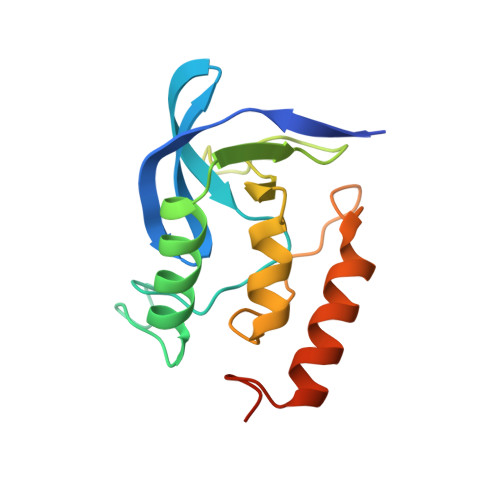Accommodation of insertion mutations on the surface and in the interior of staphylococcal nuclease.
Keefe, L.J., Quirk, S., Gittis, A., Sondek, J., Lattman, E.E.(1994) Protein Sci 3: 391-401
- PubMed: 8019410
- DOI: https://doi.org/10.1002/pro.5560030303
- Primary Citation of Related Structures:
1STA, 1STB - PubMed Abstract:
Alignment of homologous amino acid sequences reveals that insertion mutations are fairly common in evolution. Hitherto, the structural consequences of insertion mutations on the surface and in the interior of proteins of known structures have received little attention. We report here the high-resolution X-ray crystal structures of 2 site-directed insertion mutants of staphylococcal nuclease. The structure of the first insertion mutant, in which 2 glycine residues were inserted on the protein surface in the amino-terminal beta-strand, has been solved to 1.70 A resolution and refined to a crystallographic R value of 0.182. The inserted residues are accommodated in a special 3-residue beta-bulge. A bridging water molecule in the newly created cavity satisfies the hydrogen bonding requirements of the beta-sheet by forming a bifurcated hydrogen bond to 1 beta-strand, and a single hydrogen bond to the other beta-strand. The second insertion mutant contains a single leucine residue inserted at the end of the third beta-strand. The structure was solved to 2.0 A resolution and refined to a final R value of 0.196. The insertion is accommodated in a register shift that changes the conformation of the flexible loop portion of the molecule, relaxing and widening the omega turn. This structural alteration results in changes in position and coordination of a bound calcium ion important for catalysis. These structures illustrate important differences in how amino acid insertions are accommodated: as localized bulges, and as extensive register shifts.
- Department of Biophysics and Biophysical Chemistry, Johns Hopkins School of Medicine, Baltimore, Maryland 21205.
Organizational Affiliation:


















